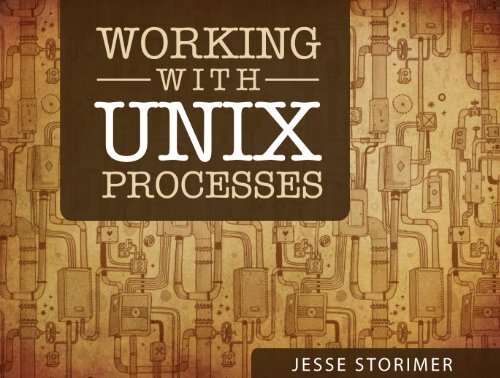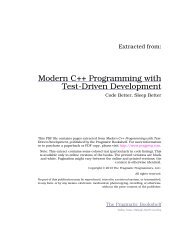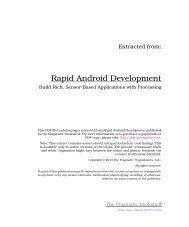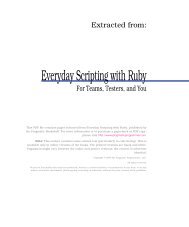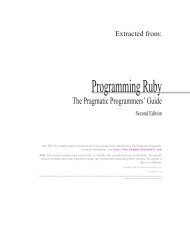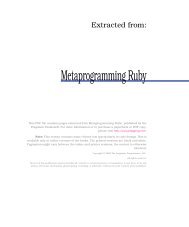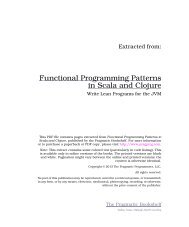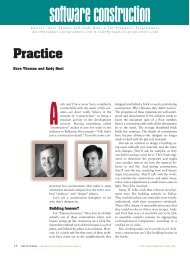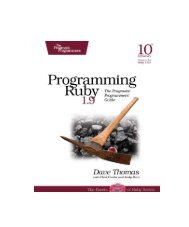Working with Unix Processes
Working with Unix Processes
Working with Unix Processes
- No tags were found...
You also want an ePaper? Increase the reach of your titles
YUMPU automatically turns print PDFs into web optimized ePapers that Google loves.
<strong>Working</strong> <strong>with</strong> <strong>Unix</strong> <strong>Processes</strong>Copyright © 2012 Jesse Storimer. All rights reserved. This ebook is licensed forindividual use only.This is a one-man operation, please respect the time and effort that went into thisbook. If you came by a free copy and find it useful, you can compensate me athttp://working<strong>with</strong>unixprocesses.com.AcknowledgementsA big thank you to a few awesome folks who read early drafts of the book, helpedme understand how to market this thing, gave me a push when I needed it, andwere all-around extremely helpful: Sam Storry, Jesse Kaunisviita, and Marc-AndréCournoyer.I have to express my immense gratitude towards my wife and daughter for not onlysupporting the erratic schedule that made this book possible, but also always beingthere to provide a second opinion. Without your love and support I couldn't havedone this. You make it all worthwhile.2
Chapter 17Daemon <strong>Processes</strong>Daemon processes are processes that run in the background, rather than under thecontrol of a user at a terminal. Common examples of daemon processes are thingslike web servers, or database servers which will always be running in thebackground in order to serve requests.Daemon processes are also at the core of your operating system. There are manyprocesses that are constantly running in the background that keep your systemfunctioning normally. These are things like the window server on a GUI system,printing services or audio services so that your speakers are always ready to playthat annoying 'ding' notification.The First ProcessThere is one daemon process in particular that has special significance for youroperating system. We talked in a previous chapter about every process having aparent process. Can that be true for all processes? What about the very first processon the system?This is a classic who-created-the-creator kind of problem, and it has a simple answer.When the kernel is bootstrapped it spawns a process called the init process. Thisprocess has a ppid of 0 and is the 'grandparent of all processes'. It's the first one andit has no ancestor. Its pid is 1 .90
Creating Your First Daemon ProcessWhat do we need to get started? Not much. Any process can be made into a daemonprocess.Let's look to the rack project 1 for an example here. Rack ships <strong>with</strong> a rackupcommand to serve applications using different rack supported web servers. Webservers are a great example of a process that will never end; so long as yourapplication is active you'll need a server listening for connections.The rackup command includes an option to daemonize the server and run it in thebackground. Let's have a look at what that does.Diving into Rackdef daemonize_appif RUBY_VERSION < "1.9"exit if forkProcess.setsidexit if forkDir.chdir "/"STDIN.reopen "/dev/null"STDOUT.reopen "/dev/null", "a"STDERR.reopen "/dev/null", "a"elseProcess.daemon1.http://github.com/rack/rack91
endendLots going on here. Let's first jump to the else block. Ruby 1.9.x ships <strong>with</strong> a methodcalled Process.daemon that will daemonize the current process! How convenient!But don't you want to know how it works under the hood? I knew ya did! The truthis that if you look at the MRI source for Process.daemon 2 and stumble through the Ccode it ends up doing the exact same thing that Rack does in the if block above.So let's continue using that as an example. We'll break down the code line by line.Daemonizing a Process, Step by Stepexit if forkThis line of code makes intelligent use of the return value of the fork method. Recallfrom the forking chapter that fork returns twice, once in the parent process and oncein the child process. In the parent process it returns the child's pid and in the childprocess it returns nil.As always, the return value will be truth-y for the parent and false-y for the child.This means that the parent process will exit, and as we know, orphaned childprocesses carry on as normal.2.https://github.com/ruby/ruby/blob/c852d76f46a68e28200f0c3f68c8c67879e79c86/process.c#L4817-486092
If a process is orphaned then what happens when you ask for Process.ppid ?This is where knowledge of the init process becomes relevant. The ppid oforphaned processes is always 1 . This is the only process that the kernel can besure is active at all times.This first step is imperative when creating a daemon because it causes the terminalthat invoked this script to think the command is done, returning control to theterminal and taking it out of the equation.Process.setsidCalling Process.setsid does three things:1. The process becomes a session leader of a new session2. The process becomes the process group leader of a new process group3. The process has no controlling terminalTo understand exactly what effect these three things have we need to step out of thecontext of our Rack example for a moment and look a little deeper.93
Process Groups and Session GroupsProcess groups and session groups are all about job control. By 'job control' I'mreferring to the way that processes are handled by the terminal.We begin <strong>with</strong> process groups.Each and every process belongs to a group, and each group has a unique integer id.A process group is just a collection of related processes, typically a parent processand its children. However you can also group your processes arbitrarily by settingtheir group id using Process.setpgrp(new_group_id) .Have a look at the output from the following snippet.puts Process.getpgrpputs Process.pidIf you ran that code in an irb session then those two values will be equal. Typicallythe process group id will be the same as the pid of the process group leader. Theprocess group leader is the 'originating' process of a terminal command. ie. If youstart an irb process at the terminal it will become the group leader of a new processgroup. Any child processes that it creates will be made part of the same processgroup.Try out the following example to see that process groups are inherited.puts Process.pidputs Process.getpgrp94
fork {puts Process.pidputs Process.getpgrp}You can see that although the child process gets a unique pid it inherits the group idfrom its parent. So these two processes are part of the same group.You'll recall that we looked previously at Orphaned <strong>Processes</strong>. In that section I saidthat child processes are not given special treatment by the kernel. Exit a parentprocess and the child will continue on. This is the behaviour when a parent processexits, but the behaviour is a bit different when the parent process is being controlledby a terminal and is killed by a signal.Consider for a moment: a Ruby script that shells out to a long-running shellcommand, eg. a long backup script. What happens if you kill the Ruby script <strong>with</strong> aCtrl-C?If you try this out you'll notice that the long-running backup script is not orphaned,it does not continue on when its parent is killed. We haven't set up any code toforward the signal from the parent to the child, so how is this done?The terminal receives the signal and forwards it on to any process in the foregroundprocess group. In this case, both the Ruby script and the long-running shellcommand would part of the same process group, so they would both be killed bythe same signal.And then session groups...95
A session group is one level of abstraction higher up, a collection of process groups.Consider the following shell command:git log | grep shipped | lessIn this case each command will get its own process group, since each may becreating child processes but none is a child process of another. Even though thesecommands are not part of the same process group one Ctrl-C will kill them all.These commands are part of the same session group. Each invocation from the shellgets its own session group. An invocation may be a single command or a string ofcommands joined by pipes.Like in the above example, a session group may be attached to a terminal. It mightalso not be attached to any terminal, as in the case of a daemon.Again, your terminal handles session groups in a special way: sending a signal to thesession leader will forward that signal to all the process groups in that session,which will forward it to all the processes in those process groups. Turtles all the waydown ;)There is a system call for retrieving the current session group id, getsid(2), butRuby's core library has no interface to it. Using Process.setsid will return the id ofthe new sesssion group it creates, you can store that if you need it.So, getting back to our Rack example, in the first line a child process was forked andthe parent exited. The originating terminal recognized the exit and returned controlto the user, but the forked process still has the inherited group id and session id96
from its parent. At the moment this forked process is neither a session leader nor agroup leader.So the terminal still has a link to our forked process, if it were to send a signal to itssession group the forked process would receive it, but we want to be fully detachedfrom a terminal.Process.setsid will make this forked process the leader of a new process group anda new session group. Note that Process.setsid will fail in a process that is already aprocess group leader, it can only be run from child processes.This new session group does not have a controlling terminal, but technically onecould be assigned.exit if forkThe forked process that had just become a process group and session group leaderforks again and then exits.This newly forked process is no longer a process group leader nor a session leader.Since the previous session leader had no controlling terminal, and this process is nota session leader, it's guaranteed that this process can never have a controllingterminal. Terminals can only be assigned to session leaders.This dance ensures that our process is now fully detached from a controllingterminal and will run to its completion.Dir.chdir "/"97
This changes the current working directory to the root directory for the system. Thisisn't strictly necessary but it's an extra step to ensure that current working directoryof the daemon doesn't disappear during its execution.This avoids problems where the directory that the daemon was started from getsdeleted or unmounted for any reason.STDIN.reopen "/dev/null"STDOUT.reopen "/dev/null", "a"STDERR.reopen "/dev/null", "a"This sets all of the standard streams to go to /dev/null , a.k.a. to be ignored. Since thedaemon is no longer attached to a terminal session these are of no use anyway. Theycan't simply be closed because some programs expect them to always be available.Redirecting them to /dev/null ensures that they're still available to the program buthave no effect.In the Real WorldAs mentioned, the rackup command ships <strong>with</strong> a command line option fordaemonizing the process. Same goes <strong>with</strong> any of the popular Ruby web servers.If you want to dig in to more internals of daemon processes you should look at thedaemons rubygem 3 .If you think you want to create a daemon process you should ask yourself one basicquestion: Does this process need to stay responsive forever?3.http://rubygems.org/gems/daemons98
If the answer is no then you probably want to look at a cron job or background jobsystem. If the answer is yes, then you probably have a good candidate for a daemonprocess.System CallsRuby's Process.setsid maps to setsid(2), Process.getpgrp maps to getpgrp(2). Othersystem calls mentioned in this chapter were covered in detail in previous chapters.99


